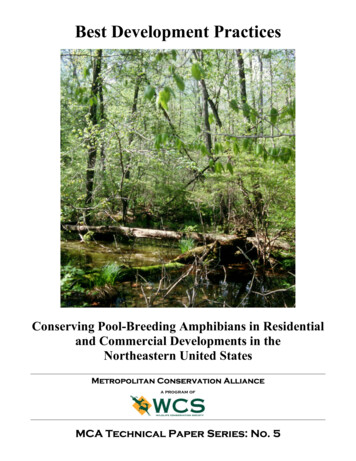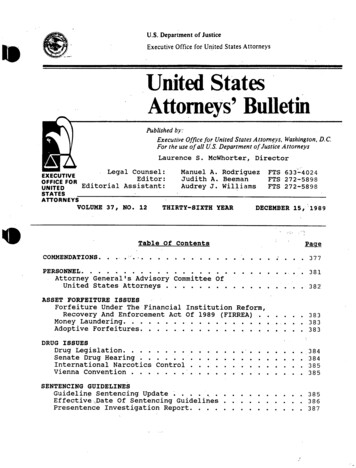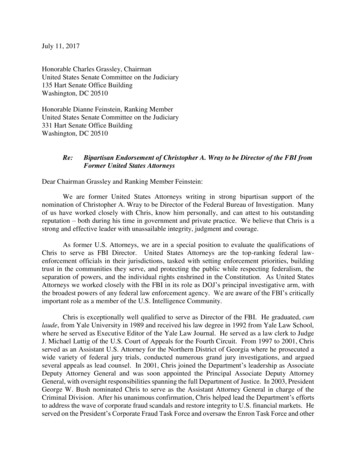
Transcription
Best Development PracticesConserving Pool-Breeding Amphibians in Residentialand Commercial Developments in theNortheastern United StatesMetropolitan Conservation Alliancea program ofMCA Technical Paper Series: No. 5
Best Development PracticesConserving Pool-Breeding Amphibians in Residentialand Commercial Developments in theNortheastern United StatesAram J. K. Calhoun, Ph.D.Maine Audubon Society1/University of Maine5722 Deering HallOrono, ME 04469calhoun@maine.eduMichael W. Klemens, Ph.D.Metropolitan Conservation Alliance/Wildlife Conservation Society268 Purchase St., 3rd FloorRye, NY 10580mca@wcs.orgCover photo Michael W. Klemens/WCSLiterature citation should read as follows:Calhoun, A. J. K. and M. W. Klemens. 2002. Best development practices: Conserving pool-breedingamphibians in residential and commercial developments in the northeastern United States. MCA TechnicalPaper No. 5, Metropolitan Conservation Alliance, Wildlife Conservation Society, Bronx, New York.Additional copies of this document can be obtained from:Metropolitan Conservation AllianceWildlife Conservation Society68 Purchase Street, 3rd FloorRye, New York 10580phone: (914) 925-9175fax: (914) 925-9164mca@wcs.orgprinted on partially recycled paper1Maine Audubon Society, 20 Gilsland Farm Road, Falmouth, Maine 04105Wildlife Conservation Society, 2300 Southern Boulevard, Bronx, New York 104602
ACKNOWLEDGEMENTSThis project was made possible through support from the Metropolitan ConservationAlliance, a program of the Wildlife Conservation Society; the Maine Audubon Society;the Maine Department of Environmental Protection (104(b)(3) EPA funds); the SwitzerFoundation; and Sweet Water Trust.We are grateful to the following people for their thoughtful reviews and participation inregional meetings: Al Breisch, Matt Burne, Elizabeth Colburn, Rich Cook, MarkFerguson, Frank Golet, Hank Gruner, John Kanter, Ruth Ladd, Carol Murphy, PeterPaton, and Chris Raithel. We especially thank Bryan Windmiller for his participation inmeetings and for providing us with his unpublished data on the impact of developmentaround vernal pools.Our document was greatly strengthened by practical input and review from professionalsin the development community, especially by Michael Divney of Divney Tung Schwalbe,LLP; Jeffrey Doynow of Fortune Homebuilders, LLC; Beth Evans of Evans Associates;and Christian Sonne of Tuxedo Park Associates.We thank David Ladd and Sally Stockwell for critical review of the manuscript. PhillipdeMaynadier also reviewed the manuscript and prepared Figure 4. Nick Miller reviewedand edited the final manuscript, and assembled Figures 8 and 9. Linda Alverson, LymanFeero, and Frank Golet provided practical information on vernal pool photointerpretationfor Appendix 2. Jennifer Schmitz prepared the final layout of the document and providedadministrative support. Becca Wilson and Damon Oscarson also provided administrativesupport during the preparation of this document.ii
TABLE OF CONTENTSAcknowledgements . iiList of Tables .vList of Figures.vPreface. viI.Introduction .1What is a Vernal Pool? .1What is Critical Terrestrial Habitat? .2Six Reasons to Conserve Vernal Pool Landscapes .3Vernal Pool Animals .4II. Planning and Assessment.6Step 1. Vernal Pool Mapping and Inventory .6Step 2. Ecological Assessment: Prioritizing Conservation Targets .7Vernal Pool Assessment Sheet .9Translating Science into Conservation.10Step 3. Putting a Conservation Plan into Action .11Incorporation into Comprehensive, Development, or Master Plans.12Acquisition.12Easements .12Overlay Zones.12Vernal Pool Ordinances .13Recognition and Voluntary Stewardship Programs.13Case Study: Jefferson Crossing—Innovative Conservation Design.14III. Management Goals and Recommendation .15Management Areas and General Recommendations.15Vernal Pool Depression .15Vernal Pool Envelope (100 ft. radius) .15Critical Terrestrial Habitat (100-750 ft.).16Summary of Management Areas .17Specific Issues and Recommendations.18Roads and Driveways .18Site Clearing, Grading, and Construction Activities .20Stormwater Management .22Accessory Infrastructure .23Lighting.24Wetland Creation and Alteration .24Post-Construction Activities .25iii
Literature Cited .36Appendix 1: Vernal Pool Regulation and Definitions .41Introduction.41Federal Regulation .41State Regulation .42Connecticut .43Maine .43Massachusetts .44New Hampshire .45New York.46Rhode Island .47Vermont .47Local Regulation.48Appendix 2: Using Aerial Photography to Locate Vernal Pools .50What Do I Use?.50What Do I Look For?.51Common Problems with Photo-Interpreting Vernal Pools .52Are National Wetlands Inventory Maps Useful for Finding Potential Pools?.53Appendix 3: Resources for Identifying Vernal Pools .54Vernal Pool Manuals .54Sources for Aerial Photography.55Government Sources.55Private Sources .56Sources for Digital Orthophotography.57National Wetlands Inventory Maps .57Field and Lab Equipment.57iv
LIST OF TABLESTable 1. Vernal Pool Indicator Species and State Conservation Status .5Table 2. Vernal Pool Facultative Species and State Conservation Status .5Table 3. Recommended Guidelines for Vernal Pools and SurroundingManagement Areas in Developing Landscapes .18LIST OF FIGURESFigure 1. Vernal Pool Size and Structure .27Figure 2. Vernal Pool Seasonality .28Figure 3. Cryptic Vernal Pools .29Figure 4. Migration Distances for Vernal Pool Amphibian Indicator Species .30Figure 5. Examples of Vernal Pool Indicator Species of the Region .31Figure 6. Examples of Vernal Pool Facultative Species of the Region.32Figure 7. Mole Salamander (Ambystoma) Life Cycle .33Figure 8. Aerial Photography Depicting Vernal Pools and Management Areas inVarying Development Settings .34Figure 9. Vernal Pool Management Areas and Recommendations .34Figure 10. Design Schematics for Road and Driveway Construction to ReduceImpacts on Pool-Breeding Amphibians .35v
PREFACEVernal pools and adjacent upland habitats contribute a vast amount of biodiversity tolandscapes of the northeastern United States. However, due to their small size, and avariety of other issues, these habitats are disproportionately impacted by developmenttrends associated with regional urban and economic growth. As a result, vernal pools—and the species that depend on them—are disappearing at a rapid rate. We must come toterms with the complexities that surround the protection of vernal pools. The BestDevelopment Practices (BDPs) in this publication present a new approach to accomplishthis goal. This document also outlines steps to identify those vernal pools worthy ofprotection. These BDPs are not, and we repeat not, new layers of regulation. Theyprovide a decision-making pathway that builds upon the strong tradition of home rulewithin our region; they add value to that home rule by enabling municipalities to becomemore effective stewards of their natural resources. We consider this a win-win solution—one that should eliminate costly delays in project approval by giving local decisionmakers the ability to reliably identify wetlands worthy of protection and, by default, otherareas where a community can plan for additional growth and development.As conservationists with real-world experience working in communities throughout NewEngland and New York, we realize our dual obligation. We need to help thosecommunities plan for their conservation needs. However, for conservation planning to betruly effective, we must also provide information to help those communities plan for theirinfrastructure and development needs. Ultimately, we view these BDPs as an exercise inempowering local decision-makers to make better, scientifically credible, and consistentdecisions. In short, we seek to replace site-by-site reactive decision-making with aframework for making multiple decisions. This is, in essence, planning. We are thankfulto the many people who contributed their time and efforts in the development of theseguidelines, including our colleagues in academia, resource management, municipalgovernment, and the development community. This is a work in progress. We lookforward to receiving feedback from users of these BDPs as to their effectiveness, and wewelcome suggestions for improvement.Aram J. K. Calhoun, Ph.D.Maine Audubon Society/University of MaineMichael W. Klemens, Ph.D.Metropolitan Conservation Alliance/Wildlife Conservation Societyvi
I. INTRODUCTIONVernal pools, and the adjacent critical terrestrial habitat used by vernal pool amphibiansduring the non-breeding season, often overlap with land slated for residential orcommercial development. These Best Development Practices (BDPs) provide apragmatic approach to stewardship that encourages communities to attain a morecomplete knowledge of their vernal pool resources, gather the information that enablesthem to designate pools that are exemplary and worthy of protection, and then developstrategies to protect them. Implementing these BDPs will better balance the needs ofvernal pool wildlife with human activities.Best Development Practices for vernal pools are recommended conservation strategiesfor residential and commercial development that minimize disturbance to vernal poolsand the surrounding critical terrestrial habitat. These BDPs:¾ provide a framework for decisionmakers to assess the quality ofindividual pool habitats;¾ have positive effects, or minimizenegative effects, of development onnatural resources;¾ provide standards based on the bestavailable science;¾ were developed with the participation ofstate agencies, scientists, resourcemanagers, and developers in the NewYork-New England region (theRegion); and¾ are offered under the premise thatvoluntary compliance, reinforced witheducation, is an effective strategy forprotecting natural resources.CAUTION! This document addresses only oneelement of the vernal pool conservation equation.Specifically, it targets pools located on privatelyowned, relatively small parcels of land (usuallyless than several hundred acres) at the suburbanrural frontier, which have been slated fordevelopment.We recognize that acomprehensive protection strategy for vernalpools must also include large tracts ofunfragmented habitat (thousands of acres) withmultiple pools. In New England and New York,these lands are primarily held by Federal andstate government, and by the timber industry. Toaddress management of these large habitat blocksin a working forest landscape, see Forest habitatmanagement guidelines for vernal pool wildlifein Maine (Calhoun and deMaynadier 2001).Owners of small woodlots may also apply theharvest principles outlined in that document.What is a Vernal Pool?Vernal pools are wetlands of great interest to ecologists because, despite their small size,they are characterized by high productivity and a unique assemblage of species adaptedto breeding in seasonally flooded wetlands (Skelly et al. 1999, Semlitsch 2000). Withinthe last decade, interest in vernal pools has increased dramatically because of wellpublicized declines of amphibians, many of which breed in vernal pools and other smallwetlands (Pechmann et al. 1991, Lannoo 1998).1
Plants and animals dependent upon vernal pools vary from state to state, as does thedefinition of a vernal pool. The following is an operational definition based on thosecommon ecological functions identified by all states in the Region:Vernal pools are seasonal bodies of water that attain maximum depths inspring or fall, and lack permanent surface water connections with otherwetlands or water bodies. Pools fill with snowmelt or runoff in the spring,although some may be fed primarily by groundwater sources. The duration ofsurface flooding, known as hydroperiod, varies depending upon the pool andthe year; vernal pool hydroperiods range along a continuum from less than 30days to more than one year (Semlitsch 2000). Pools are generally small insize ( 2 acres), with the extent of vegetation varying widely. They lackestablished fish populations, usually as a result of periodic drying, andsupport communities dominated by animals adapted to living in temporary,fishless pools. In the Region, they provide essential breeding habitat for oneor more wildlife species including Ambystomatid salamanders (Ambystomaspp., called “mole salamanders” because they live in burrows), wood frogs(Rana sylvatica), and fairy shrimp (Eubranchipus spp.).A review of vernal pool definitions either adopted or developed by each state in theRegion is provided in Appendix 1; despite varying definitions, all pools share a uniqueecology. Where available, vernal pool-associated amphibian species are listed for eachstate. Some states have not yet developed a definition for vernal pools, while others haveextremely specific definitions. Some definitions focus on physical characteristics ofpools while others are defined by the species of amphibians and invertebrates breeding inthe pools. Vernal pool identification guides are available to help citizens recognize thesehabitats. Information about these guides is provided in Appendix 3. See Figures 1, 2, and3 for images of vernal pools and associated amphibian breeding habitats.What is Critical Terrestrial Habitat?Pool-breeding amphibians depend upon both aquatic and terrestrial habitats for survival.Most adult vernal pool amphibians in the Region spend less than one month in breedingpools; the rest of their annual cycle is spent in adjacent uplands and wetlands (Semlitsch1981, 2000). The surrounding forest provides critical terrestrial habitat for adultamphibians and newly emerged juveniles throughout the year (Semlitsch 1998). In theirupland habitats, both young and adults need areas of uncompacted, deep organic litter;coarse woody debris; and shade. These elements provide a suitable forest floorenvironment for amphibians as they move through the forest, feed, and hibernate(deMaynadier and Hunter 1995, DiMauro 1998). This dependence on the surroundinglandscape for survival has prompted one researcher (Semlitsch 1998) to refer to thiscritical terrestrial habitat around pools as a “life zone,” instead of a “buffer zone.”Conservation strategies that focus only on protecting breeding pools and associatedwetlands will most likely fail to maintain healthy amphibian populations. Protection ofcritical terrestrial habitat must also be a priority (Marsh and Trenham 2001).2
SIX REASONS TO CONSERVE VERNAL POOL LANDSCAPES(1) UNIQUENESSFish-free pools provide optimal breeding habitat for a specialized group of amphibians that have evolved touse these wetlands. Vernal pool amphibian eggs and larvae are extremely vulnerable to fish predation.Even though vernal pool amphibians may breed in wetlands where fish are present, survival of eggs andlarvae in such environments is limited (Petranka 1998).Many vernal pool amphibians return to breed in the pools where they developed (Duellman and Trueb1986, Berven and Grudzin 1990, Sinsch 1990) and show little tendency to relocate if their breeding habitatis disturbed (Petranka et al. 1994). Protecting vernal pools is a critical first step in conserving vernal poolamphibians.(2) HABITATSmall wetlands and vernal pools contribute significantly to local biodiversity by supporting an abundanceof plants, invertebrates, and vertebrates that would otherwise not occur in the landscape (Semlitsch andBrodie 1998, Gibbs 2000). Many small mammals, birds, amphibians, and reptiles use these wetlands forresting and feeding. The average travel distance for frogs, salamanders, and small mammals is less than0.3 km (Gibbs 1993, Semlitsch 1998, Semlitsch and Bodie 1998). The destruction of small wetlands in thelandscape increases the distances between remaining wetlands. Often, these distances are greater thanthese animals can travel. Large mammals (e.g., bear, moose) use these small wetlands as a food source.Rare wildlife, including state-listed species, may use pools (see Tables 1 and 2).(3) WEB OF LIFEVernal pools contribute a significant amount of food (e.g. amphibians and insects) to adjacent habitats(Semlitsch et al. 1996, Skelly et al. 1999). This food production is fueled by decaying leaves (organicmatter) that are deposited in these pools each fall. After emerging from the vernal pool, wood frogs andsalamanders may be eaten by a wide variety of forest animals including snakes, turtles, birds, and smallmammals (Wilbur 1980, Pough 1983, Ernst and Barbour 1989). For example, in one Massachusetts vernalpool, Windmiller (1990) found that the weight of all the vernal-pool breeding amphibians exceeded theweight of all breeding birds and small mammals in the 50-acre upland forest surrounding his study pool.He concluded that vernal pool amphibians exert a powerful influence on the ecology of surroundingforests, up to 0.25 miles from the edge of the pool.(4) SAFETY NETVernal pools are so small that they frequently fall through the regulatory cracks. Because vernal pools areoften small in size and hard to identify, they are inadequately protected by state or local wetlandregulations. An overview of state regulations for vernal pools is presented in Appendix 1.(5) EDUCATIONAL RESOURCEA vernal pool is a small ecosystem, easy to “wrap your arms around.” As such, it makes an ideal outdoorlaboratory for school children and adults. Often, a local pool can be visited or people discover that theyhave a vernal pool on their own property. These pools are often rich with life and easier to becomeintimate with than lakes or rivers.(6) AESTHETICSThe rich array of moss-covered logs, delicate shades of greens and browns through dappled sunlight, andthe beauty of the vividly marked or masked amphibians that breed in these sylvan gems, are allinspirations.3
Amphibians, reptiles, and small mammals also need suitable upland habitat connectingwetlands. These animals live in small populations or small units that, together, make alarger population. These small populations often mix through dispersal of juveniles. Forexample, small populations may replenish one another with new breeding stock whennatural catastrophes (e.g., drought or freezing) eliminate breeding adults or cause larvalfailures in certain pools.The average distance that a spotted salamander moves from a pool into the surroundingforest is 386 feet; Jefferson salamanders may travel 477 feet (see Figure 4; Windmiller1996; Semlitsch 1998; Faccio, in prep.) with as much as half the population, in someinstances, travelling even greater distances. Wood frog juveniles, on average, disperseapproximately 1,550 feet from a breeding pool (Berven and Grudzien 1990). Therefore,long-term persistence of vernal pool amphibian populations depends on the availabilityof habitat that connects local populations and enables dispersal among them (Semlitschand Bodie 1998).Other animals (including reptiles, birds, and small mammals) also depend on these smallwetlands. Beetles and water bugs, for example, that overwinter in permanent watermigrate to vernal pools to breed and feed during the spring and summer. Medium- tolarge-sized mammals, including raccoon, skunk, fox, deer, moose, and bear, visit pools tofeed on amphibian eggs and fresh green shoots emerging in spring or, later in the season,on amphibians and insects. Therefore, the loss of individual vernal pools may weakenthe health of entire wildlife communities.The bottom line: Connections between pools, through the upland landscape, must bemaintained to accommodate population movements—dispersal to and from pools forbreeding, foraging (feeding), resting, and replenishing locally extinct populations.Vernal Pool AnimalsMany definitions of vernal pools contain language referring to “obligate” or “indicator”species. Obligate species depend upon vernal pools for successful breeding. However,many so-called obligate species, such as wood frogs and spotted salamanders, breed inother wetlands, including roadside ditches, artificial wetlands, and small ponds.However, in many of these breeding sites, the survival of the eggs and production ofjuveniles may be greatly diminished. We suggest using the term “indicator” species as amore ecologically accurate term. A list of vernal pool indicator species of the Region,with state conservation status information, is provided in Table 1; images ofrepresentative indicator species are provided in Figure 5.The term “facultative” species commonly refers to animals that use the pools for restingand foraging; they might reproduce in vernal pools, but use other habitats forreproduction as well. A list of vernal pool facultative species in the Region, with stateconservation status information, is provided in Table 2; images of representativefacultative species are provided in Figure 6.4
Table 1. Vernal pool indicator species and state conservation status(E endangered, T threatened, SC special concern, P present, A absent).INDICATOR SPECIESBlue-spotted salamanderJefferson salamanderSpotted salamanderMarbled salamanderTiger salamanderWood frogSpadefoot toadFairy TNYSCSCPSCEPSCPT1The blue-spotted salamander is extirpated in Rhode Island.Blue-spotted pure diploid populations are listed as Threatened; the blue-spotted hybrid complex is listed asSpecial Concern.3Unsubstantiated historic records; no populations have been located (Andrews 2001).4Fairy shrimp comprise a group of several related crustaceans throughout the region; “P” indicates presenceof one or more species.5In Massachusetts, the Intricate Fairy Shrimp is listed as Special Concern.2Table 2. Vernal pool facultative species and state conservation status1(E endangered, T threatened, SC special concern, P present, H historical record only, A absent).FACULTATIVE SPECIESNorthern cricket frogWestern chorus frogFour-toed salamanderSpotted turtleWood turtleBlanding’s turtleEastern box turtleEastern ribbon snakeEastern hognose snakeRinged boghaunter CHENYEPPSCSCTSCPSCHFor the purposes of this table, we have combined RI’s categories of SI (State Interest) and C (Concern) toequal Special Concern (SC).In-depth natural history accounts of pool-breeding amphibians and other species can befound in Amphibians and Reptiles of Connecticut and Adjacent Regions (Klemens 1993),Amphibians and Reptiles in Connecticut: A Checklist with Notes on Conservation Statusand Distribution (Klemens 2000), Maine Amphibians and Reptiles (Hunter et al. 1999), AField Guide to the Animals of Vernal Pools (Kenney and Burne 2000), A Guide toAmphibians and Reptiles (Tyning 1990), and Salamanders of the United States andCanada (Petranka 1998). See Figure 7 for examples of various stages within a molesalamander (Ambystoma) life cycle.5
II.PLANNING AND ASSESSMENTThis section complements Section III; Management Goals and Recommendations, byproviding step-by-step guidelines to develop a locally based conservation plan for vernalpools. Conservation of vernal pool-breeding amphibian habitat is often most effective atthe local level where neighbors, planners, and other concerned citizens play an activestewardship role. The planning process will take time and many hands to develop andimplement, and should not take the place of, or delay, the application of managementrecommendations to individual projects as they arise.Effective planning for vernal pool conservation at themunicipal level requires long-term vision instead of shortterm crisis reaction. This enables communities to plan forthe protection of vernal pool resources as a subset of theiroverall master planning process. Therefore, it is not viewedas inconsistent or discretionary, but rather as a legitimatepart of the jurisdiction's accepted and approved developmentgoals. Three sequential steps for local conservation arepresented: (1) vernal pool mapping and inventory, (2) vernalpool ecological assessment, and (3) developing conservationactions.NOTE: Clustering developmentaway from vernal pools and otherkey resources is an importantplanning tool.It not onlyconserves open space, but alsoreduces impervious surfaces andaccessory infrastructures.CAUTION! The ab
Paper No. 5, Metropolitan Conservation Alliance, Wildlife Conservation Society, Bronx, New York. Additional copies of this document can be obtained from: Metropolitan Conservation Alliance Wildlife Conservation Society 68 Purchase Street, 3rd Floor Rye, New York 10580 phone: (914) 925-9175 fax: (914) 925-9164 mca@wcs.org











